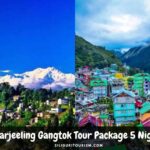Zero Point in Sikkim (also called Yumesamdong) is located at a high altitude of 15,300 feet in North Sikkim, India. It’s known as “Zero Point” because this is the last point vehicles can reach—no roads go beyond here, and visitors can’t continue due to its closeness to the Chinese border.
It’s about 26 kilometers from Yumthang Valley, and getting there usually takes over an hour. This spot is actually the farthest part of Yumthang Valley. The road to Zero Point is challenging, requiring both skill and bravery to drive. The route has many sharp turns and passes through rugged, rocky mountains, making the journey both exciting and a bit risky.
In summer (March–June), Zero Point in Sikkim has pleasant temperatures between 14°C and 20°C, making it the best time to visit for its blooming flowers. During the monsoon (June–September), heavy rain and strong winds bring cooler temperatures from 4°C to 18°C.
Autumn (October–November) offers clear skies and mild weather, with temperatures between 7°C and 15°C, perfect for viewing the mountains. Winter (December–February) brings heavy snowfall, with temperatures dropping as low as –17°C.
Attractions
Zero Point, also known as Yumesamdong, is a top attraction in North Sikkim. Its remote location and peaceful surroundings make it unique in the Northeast. Located at the farthest end of North Sikkim, it offers incredible, serene views. This beauty has earned Zero Point a reputation as a “paradise on earth.”
The road to Yumesamdong goes through beautiful mountains. Along the way, colorful bushes of Rhododendron anthopogon, called Sunpaati in Nepali, fill the air with a soft, pleasant smell. The local people use these plants as incense for their religious rituals.
This stunning natural beauty attracts thousands of visitors each year, making it an ideal spot for those who want to enjoy the peace of nature. The unique charm of Zero Point in Sikkim captivates everyone who visits.
Yumesamdong is covered in snow all year, which is a big draw for tourists. Due to the high altitude at Zero Point, snow is present most of the time. As the snow melts, the area transforms into a lush, green meadow, creating a large grazing ground for nomadic shepherds. Sometimes, blue sheep can also be seen grazing in the area.
Do’s and Donts
When visiting Zero Point, Sikkim, it’s important to be prepared for the high altitude and extreme cold. Start by consulting a doctor before your trip, especially if you’re visiting in winter, as the oxygen levels are lower here. Dress warmly, as the area is cold year-round, and pack essentials like medicines, moisturizers, and sunglasses (to protect against the glare from snow).
Research the area before your first trip and bring your own snacks, as there are limited shops around; you’ll find small food stalls selling tea, pakoras, and momos along the way.
Once there, embrace the peace and natural beauty of the valley, ideal for relaxing, taking photos, and enjoying local tea and momos to stay warm. If you’re feeling adventurous, explore activities like trekking, hiking, village visits, and relaxing in nearby hot springs. However, don’t underestimate the cold and be cautious about altitude effects.
Zero Point Temperature
In summer (March to June), the temperature at Zero Point in Sikkim stays between 14°C and 20°C, which is pleasantly cool. This is the best time to visit because the valley is full of blooming flowers in many colors.
During the monsoon season (June to September), there is heavy rainfall and strong winds, with temperatures ranging from 4°C to 18°C.
Autumn (October to November) has clear skies and dry weather, making it a great time to see the stunning mountain views. Temperatures are between 7°C and 15°C.
In winter (December to February), Zero Point experiences heavy snowfall, and the temperature can drop to as low as –17°C.
Best Time to Visit
Zero Point (Yumesandong) is beautiful all year round, with each season bringing its own unique charm. You can plan your visit based on what you like most. The best time to visit is from late March to June when the valley below Zero Point blooms into a paradise, covered in thousands of colorful flowers.
If you’re looking for snowfall, winter is the perfect time to visit. For clear skies and stunning views of snow-covered mountains, autumn is ideal. While the monsoon season can also be a good time to visit, heavy rains may cause landslides and road blockages, which could be inconvenient.
How to Reach
Zero Point Sikkim is located at a high altitude, 26 km from Yumthang Valley. It is a remote and isolated area, standing as the farthest point in North Sikkim, where the motorable roads end. To get there, you need to drive along winding roads through a stunning mountainous landscape.
The journey offers breathtaking views, and driving through the rugged, vegetation-free terrain is an unforgettable experience. You can hire vehicles from travel operators in Gangtok, Lachung, or Yumthang Valley. The cost of the trip from Yumthang Valley to Zero Point may vary depending on the time of year and season.
| Get a Free Tour Quote |
|---|




